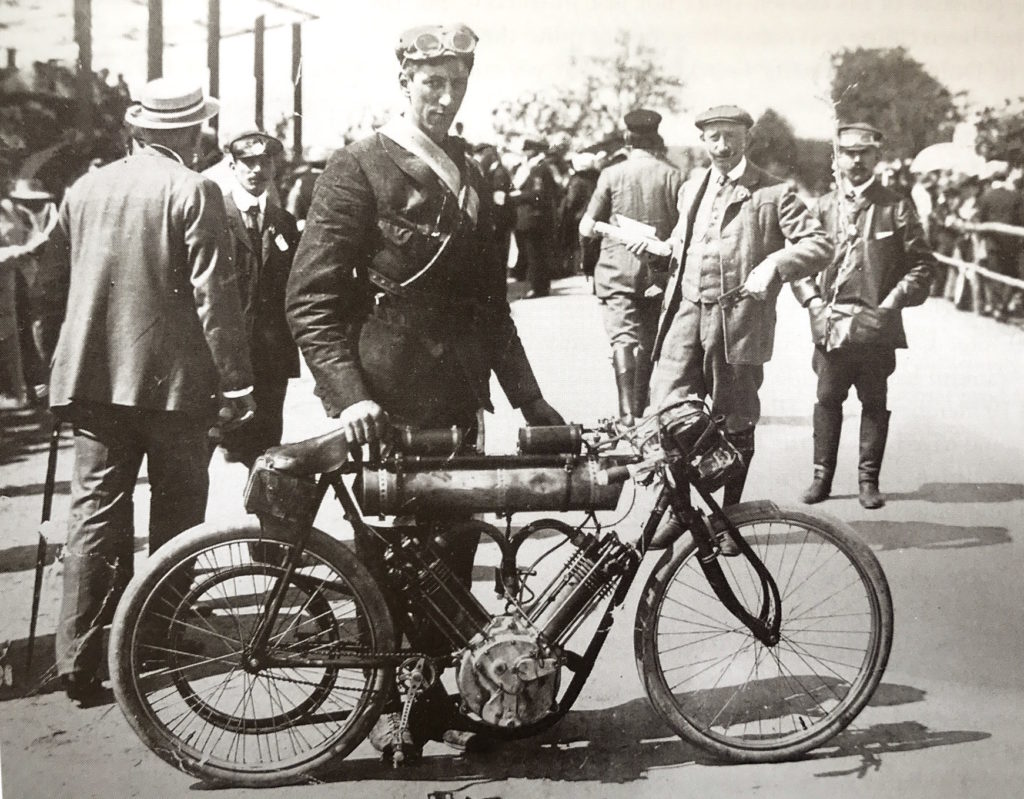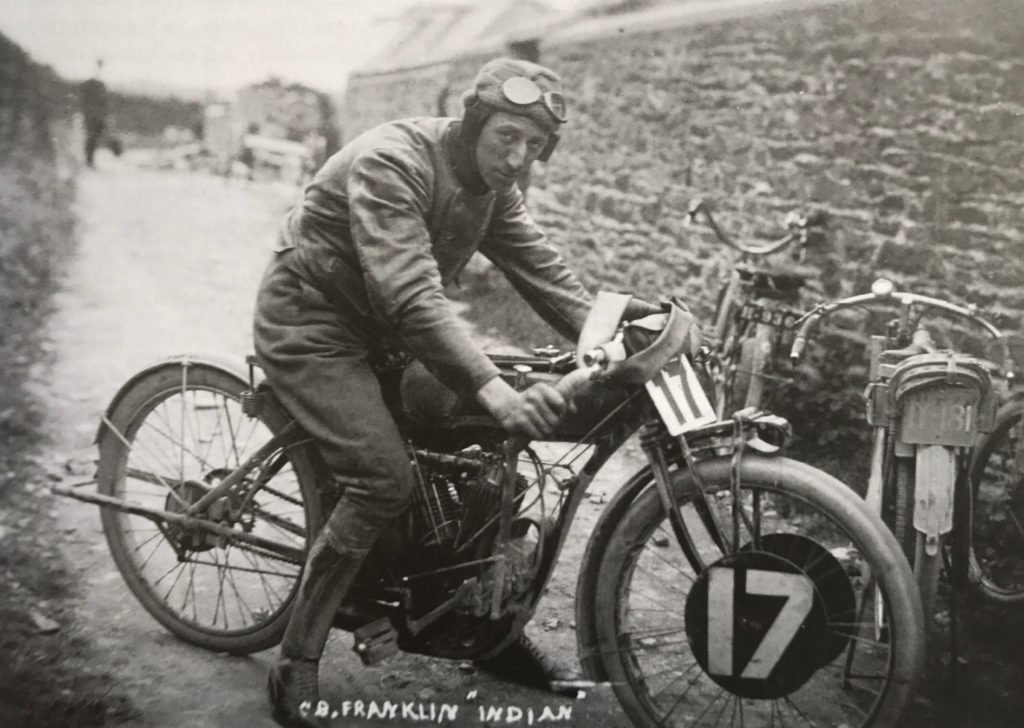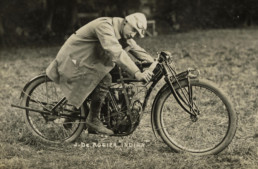[Adapted for TheVintagent from the excellent book ‘Franklin’s Indians’]
Charles Bayly Franklin was born on 1st October 1880 in Dublin, Ireland, and died on 19th October 1932 in Springfield, Massachussetts, USA, at the age of 52. He was descended from English settlers who came to Ireland during the 17th Century to be farmers. His grandfather’s occupation was stated simply as “gentleman”, while his father was a shipwright and a metal merchant. Charles was educated at a good private school where he showed an aptitude for sciences, and proceeded into tertiary education as an electrical engineer.


By 1905 Franklin was acknowledged to be the first major star of Irish motorcycle competition, and so it was no surprise when he announced his intention to enter, at his own expense, the selection trials held on the Isle of Man to choose a British team for the International Cup Race in France. His machine was a specially ordered JAP 6hp vee-twin, built into a frame of his own design made from Chater-Lea components (who typically supplied raw frame castings). In the selection trial he was up against top riders like the Collier brothers from the Matchless factory in London. Franklin was in the lead until the fifth and last lap, when valve trouble stopped him from finishing. But he had ridden so consistently well that he got selected anyway, along with Harry Collier and JS Campbell. But in France all three had to drop out with mechanical problems and the race results overall were discredited due to rule-bending by the host-country organisers. Simply by being there, Franklin gained the honour of being first to represent Ireland in international motorcycle competition.

Franklin was selected again for the 1906 British team for the International Cup race, this time held in Austria, and his two team mates were both of the Collier brothers – Harry and Charlie. He rode a giant 8hp JAP vee-twin, and again, the race was plagued with rule-bending and chicanery, but protests were ignored by the organizers. On the train journey back to England the two Colliers, Franklin, their team manager the Marquis de St Maur, and the Auto Cycle Union’s Freddy Straight got to talking. Why not hold a British race? Why not encourage standard road and touring models to enter, instead of freakishly light-weight speed models? But where? In Britain, motor racing on public roads was explicitly outlawed, and a national speed limit of 20mph was in place. So the ACU went to the Isle of Man, which has always had an autonomous parliament, the Tynwald. Recognizing the economic benefits from the thousands of visitors drawn to such an event, the first “Isle of Man Tourist Trophy Race” was announced in 1907. Unfortunately, Franklin couldn’t go; work pressures kept him in Dublin. But he did compete on The Island in 1908, even though his wife had given birth to their first child only 3 days prior! His mount was another JAP single-cylinder machine with Chater-Lea frame, and he did creditably well, coming 6th. The race was won by a Triumph…a fact duly noted by Franklin, as sure enough, in the 1909 TT Franklin appeared on a Triumph coming 5th, and bringing home the Private Owners Prize. Not bad, for an amateur who competed against factory-supported teams!

1909 was the first year Indian racers appeared in the TT, and the lesson Franklin took from the brilliant ride of Lee Evans against Harry Collier is that if one wanted to do well in this race then one really needed to be riding an Indian [or be Harry Collier! – pd’o]. Thus, Franklin was one of several private owners who arrived at the Isle of Man in 1910 on Indian twins, augmenting the officially factory supported Indian team of Evans, Bennett and Bentley. Billy Wells must have supported all of the Indian riders by giving them tyre inner tubes, and all proved to be from the same bad batch. A rear tyre blow-out on the infamous Devil’s Elbow bend saw Franklin crash into the stone wall, nearly going over it and down a cliff. It was not an Indian day.

In 1910 Franklin resigned his post at the power station and opened an Indian agency at his suburban house in Dublin. He rode exclusively on Indians, and dedicated himself totally to Indian competition, sales and service, from that day forth. This change of career also gave him the freedom to start competing at the Brooklands Track in England, where he consistently did well against the Collier Brothers and other top cracks, billed as “the Irish Champion”. Indian’s luck changed in the 1911 TT race, now run over Snaefell Mountain, which gave Indian a real advantage with their all-chain drive and two-speed countershaft gearbox. Among the British entrants only Scott and P and M (later Panther) could boast similar arrangements. Other brands used direct belt-drives, sometimes with variable pulleys or epicyclic rear-hub gears; all engineering dead-ends. Franklin rode a steady and flawless race which saw him ultimately take 2nd place, his best-ever TT result.

Race reports described him as “a quiet chap” but “a fearless rider with plenty of good judgement” and one who rides “with the regularity of a well-timed express train”. He was also described as “an Indian convert”. In 1915 Indian’s British concessionaire Billy Wells decided to open a Depot in Dublin for Indian sales and service. He recruited Charles Franklin into the Indian company to be the Dublin manager. But in 1916 wartime conditions and import restrictions forced Wells to close the Dublin end of the British operation. Wells, by now a Director on the Indian board, was able to have Franklin transferred to the Wigwam in the USA where he entered the Design Department.

He was the first designer at Indian to have formal engineering qualifications. Franklin’s subsequent achievements at Indian are another story entirely, for it was Franklin who designed the Indian Scout and Chief models. These holistically designed machines are said by many to be among the very first examples of the ‘modern motorcycle’. They were influential models, and their sales saw Indian through difficult economic times in the early and late ‘twenties. In racing too he continued to contribute to Indian glory, this time as race engine designer and tuner, and overseer of the Indian racing effort against the famous Harley “Wrecking Crew” of 1919-1922 and beyond. But by 1931, the start of the du Pont era at Indian, Franklin does not look very well in official company photos. In August of 1931 he asked for a leave of absence to recover his health. He got steadily worse and passed away in October 1932, of bowel cancer.

Franklin was a man with a rare combination of talents. He had the sporting qualities and the moxie necessary to succeed in the cut-throat world of motorcycle racing. And he had the education, intellect and marketing instinct needed to succeed in the manufacturing side of his beloved motorcycle industry. From the 1911 TT race Charles Bayly Franklin went on to become one of the world’s great motorcycle designers.

[Adapted from the book ‘Franklin’s Indians’, by Timothy Pickering, Chris Smith, Harry V. Sucher, Liam Diamond, and Harry Havelin, available here]
Related Posts
August 2, 2017
100 Years After the ‘Indian Summer’, Part 2: Jake De Rosier
Jake De Rosier was perhaps the first…
July 27, 2017
100 Years After the ‘Indian Summer’, Part 1: Billy Wells
Over 100 years ago, Indian swept the…



Franklin was an electrical engineer, and studied at Dublin in these days. Thus, even being one of the best within indian, and knowing Hedstrem had NO diploma to manage the success story till 1913 (left!) … I rather suggest to underline the result than the “formation” story on his behalf.
regards